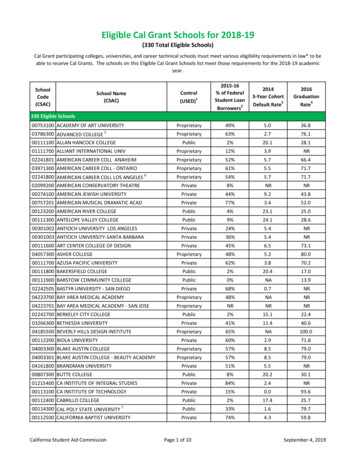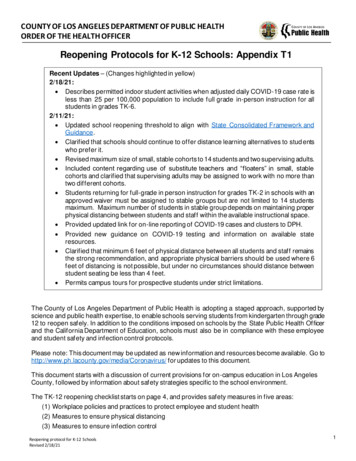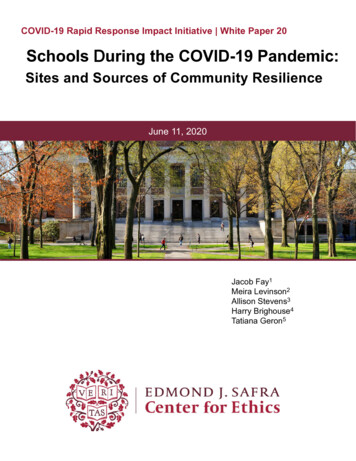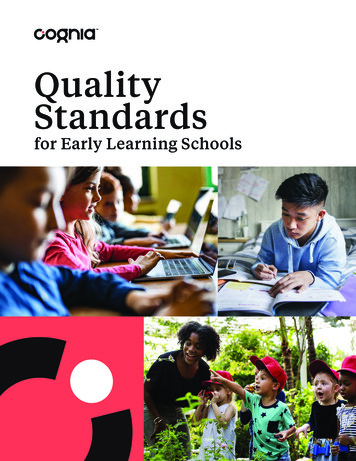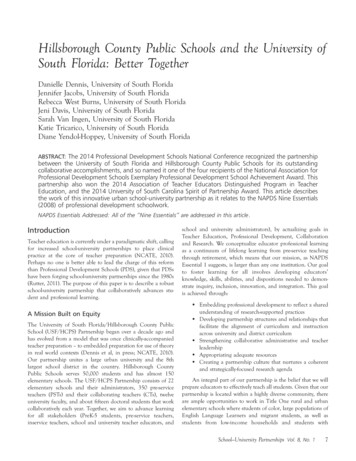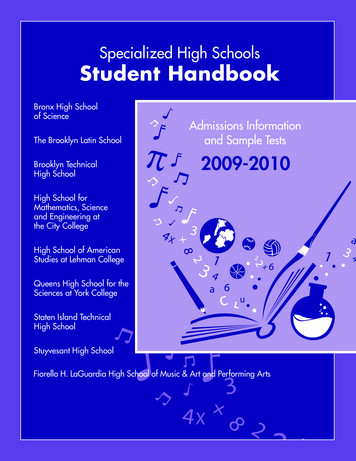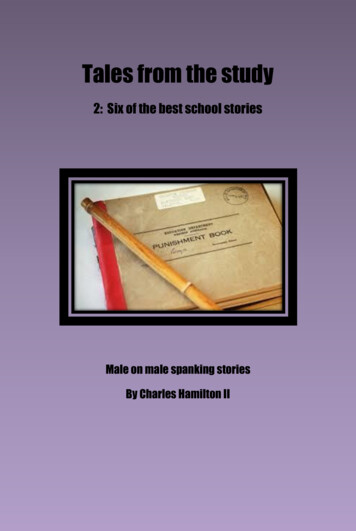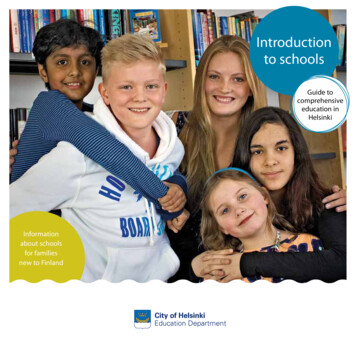
Transcription
Introductionto schoolsGuide tocomprehensiveeducation inHelsinkiInformationabout schoolsfor familiesnew to Finland1
”Hello!This is the Introduction to schools Guide that includes thekey information about the Finnish comprehensive education. The guide provides support for your family in startingschool in Helsinki and starting a new stage in your lives.In Finland, education is compulsory for every child andevery child has a right to go to school. It is easy; basic education, learning materials and the daily lunches are all free.These are paid by the city of Helsinki with tax money.At school, pupils acquire knowledge and skills that willeventually help them to find their own place in society.Pupils learn to recognise their strengths and to work together with others.All this takes place in an encouraging and safe environment with teachers supporting pupils as individuals and aspart of a group. Teachers develop different learning environments in which the students can find the best way oflearning for themselves.We hope that this guide will provide answers to anyquestions your family has. Teachers and other staff at yourschool will be happy to tell you more.Wishing you a happy start at school!”Marjo KyllönenEducational ManagerCity of Helsinki Education DepartmentBasic Education Division2
ContentsPolina's and Kushali'sday at schoolSuitable schooling for every pupil. . . . . . . . . . . . . . . . . 4During the school day, Polina, aged9, did gymnastics and Kushal, aged13, took a history test. Between thelessons, they spent time with theirfriends. Both pupils enjoyed a freelunch.Read their stories on pages 8 and 12Some practical issues. . . . . . . . . . . . . . . . . . . . . . . . . . . . . 5Teaching and timetable of grades 1 to 6 . . . . . . . . . . 6Pupil's voicePolina's Friday in grade 2. . . . . . . . . . . . . . . . . . 8Teaching and timetable of grades 7 to 9 . . . . . . . . . 10Pupil's voiceKushal's Friday in grade 7 . . . . . . . . . . . . . . . 12School days are filled with activities. . . . . . . . . . . . . . 14Mastering the mother tongueand FinnishLanguage skills enable pupils to learnand make friends . . . . . . . . . . . . . . . . . . . . . . . 16Teacher Päivi Lavonen: ”S2 instructioncreates opportunities for the future”. . . . . . . . . . . . . . 17Pupils are able to learn when they master theirmother tongue and the Finnish language. This iswhy pupils participate in S2 instruction (Finnishas a second language) until their language skillsare at the level of those whose mother tongue isFinnish. In addition, pupils may have two lessonsper week to study their mother tongue.Read more on pages 16 and 17Religion or ethics. . . . . . . . . . . . . . . . . . . . . . . . . . . . . . . . 18Holistic assessment. . . . . . . . . . . . . . . . . . . . . . . . . . . . . . 19After-school activities. . . . . . . . . . . . . . . . . . . . . . . . . . . . 20School year. . . . . . . . . . . . . . . . . . . . . . . . . . . . . . . . . . . . . . 22School and home cooperation . . . . . . . . . . . 24Parents and children: ”We use Wilmato discuss issues with the teachers” . . . . . . . . . . . . . . 25School and homes workin close cooperationHelp and support for learning . . . . . . . . . . . . . . . . . . . 26Education paths in Finland. . . . . . . . . . . . . . . . . . . . . . . 28Alternatives for those left without a placein upper secondary education. . . . . . . . . . . . . . . . . . . 29Study Counsellor Tiina Valtonen:”Study and find work”. . . . . . . . . . . . . . . . . . . . . . . . . . . . 30More information on education and training. . . . . 31Communication between guardians and teachers supports children in learning. Messages aresent and received via the internet.Read more on pages 24 and 253
Suitable wayfor every pupil to go to schoolComprehensive education is a part oflife for all children and young peoplein Finland. According to the BasicEducation Act ”compulsory schoolingshall start in the year during whichthe child turns seven. Compulsory schooling shall end when the basiceducation syllabus has been completed or ten years after the beginning ofcompulsory schooling. The parent/carer of the pupil in compulsory education shall see to it that compulsoryschooling is completed”.When compulsory schooling hasbeen completed, pupils are issuedwith a final certificate. The certificateis used when applying for a place inupper secondary schools or vocational institutions.Place in a local schoolThe City of Helsinki places each pupilin a comprehensive school of thepupil's living area, this is called thelocal school. Helsinki also has privately contracted schools within thecity's school network, as well as private and state-owned schools.Instruction preparing forprepatory educationPupils who have just moved to Finland will attend prepatory educationclass if their language skills in Finnishare not sufficient enough for studyingin a basic education group. The preparatory education normally lastsfor one year. After that, pupils will beintegrated into their local school.Special needsin educationEach child has an individual methodand pace for learning. The school willconsider the special needs in teachingof the pupil and there will be a suitable schooling/teaching for each individual pupil. Learning support isavailable at general, enhanced andspecial-needs level.Weighted-curriculum andforeign-language educationPupils can apply to a school offeringweighted-curriculum or foreign- language education. Weighted- curriculum means that pupils in theschool can study certain subjects, e.g.music, a little more than normally.4In foreign-language educationsome of the instruction is in Finnish and some in another language, or allinstruction is in another language.Schools offering weighted-curriculumand foreign-language education useaptitude tests to select their pupils.Read morewww.hel.fi/palvelukartta Teachingand educationAll education-related services on amap of Helsinki.How to enrolyour child in schoolThe Education Departmentsends notification of compulsoryschooling by post to familiesliving in Helsinki. The notification includes detailed enrolmentinstructions.If your family has moved toHelsinki recently, you should visitthe office of a school near yourhome or the Education Department's information services orinformation desk at the offices.
Somepractical issuesThe family and the teacher meet eachother before the pupil starts school.This way, the school building, theclassroom and the teacher will befamiliar. The teacher will talk aboutstarting school, and the school secretary will help with the practical issues.Teacher's tipsfor starting school1. Take care of suitable clothingPupils go outside during breaks. In thewinter, children need warm outdoorclothes for school, such as quiltedjackets and trousers. School uniformsare not used in Finland.2. Learn the route to schoolPractice the route the school withyour child. It is important to arrive atschool on time, a little before the startof the school day.If your child travels several kilometres to school and takes the bus,metro or train, they may be entitledto a free pass or ticket. Ask for moreinformation at the school office.City of Helsinki takes out insurance policies for all pupils in caseof accidents. The insurance is validat school, on the way to and fromschool, and during planned activitiesoutside the school arranged withinthe framework of the curriculum.3. Prepare for starting schoolFor school, your child will need a bag,a pencil case, and clothes for indoorand outdoor sports. Teaching, mate-rials and school lunch are free ofcharge.4. Read this guide and talk toyour childTalk with you child about any questions they may have. Encourage yourchild by telling them that they can askthe teacher anything.Every school day includes short breaks. Pupils spend the breaks in the schoolyard with their friends. Older pupils may spend their breaks indoors. Teacherssupervise break times.5
Teaching andtimetable of grades 1 to 6During the first years at school, pupilsacquire important information andbasic skills, and they learn to manageissues related to going to school. Theylearn how to work in a group andmake friends. The number of subjects and amount of homework willincrease gradually. School days willalso become longer.Curriculum providesguidelines for school workSchools in Helsinki follow a local cur-riculum prepared on the basis of thenational core curriculum. The contents of the subjects taught, amongother education-related issues aredetermined in the local curriculum.The curriculum regulates teaching andall activities in schools. The distribution of lesson hours for all schools inFinland is decided nationally.In addition, each school has anindividual curriculum explaining theway the school works and where thefocus is.In grades 1 to 6pupils study this Finnish language and literature, Finnish as a secondlanguage (S2) A language B language Mathematics Environmental and naturalsciences* Biology Geography Physics Chemistry Religion or Ethics History/Civics Music Visual arts Textile and technical work Physical education* As of 1 August 2016, environmental and natural scienceswill include biology, geography, physics and chemistry.Swimming lessons arepart of physical educationPupils in grades 1 to 5 participate in swimming lessons.Teachers assess swimming skillsas part of physical education.Pupils go swimming four timesa year.In the first grades, pupils acquire basic knowledge and skills.6
Example of a timetable for grade 2The timetable is a plan for the week.TIMEMON8.15–9TUEWEDMother tongueTHUFRIGroup AGroup B9–9.45Group AMother tongueGroup XXPhysical 1–12XXXXPhysical ��1XFinnish S2Finnish S2Religion or �2XGroup BGroup AX A lesson for the whole class, where pupils will study one of the following subjects: biology, visual arts, crafts, mathematics, FinnishFinnishS2 Finnish lessonS2 (Finnish as a second language) Finnish lesson for pupils developing theirFinnish skills to the level of native speakers S2 teacher takes the S2 lessonsimultaneously with the Finnish lesson.Ethics Ethics lesson for pupils who do not belong to religious communitiesMother tongueGroup AGroup B Mother tongue lessons may be arranged at another school Group lesson with half the class present. Various subjects; focus on crafts andmathematics7
Pupil's voice:Polina'sFriday in grade 2At 8 am”It takes me five minutes to walk to school. I cameto school by myself and played in the school yardwith my friends. One of our games involves abee chasing a kitten, with the kitten's owner andmummy cat protecting the kitten. One of theteachers was supervising us in the school yard.”Polina9-year old Polina is ingrade 2. She has livedin Finland since shewas a baby. Polinagoes to Nalli annexof Keinutie Compre hensive School. Hermother is from Belarus and her father isRussian-Finnish.At 8.15 am”The school bell rang. I went in the queue withmy friends. We walked to the coat racks outsideour classroom and took off our outdoor clothesand shoes. I put on my indoor shoes. In the classroom I went to my desk and hung my rucksackon the back of my chair. I sit next to Jonne.”At 8.20 am”My teacher Miikka told us that we have physicaleducation in the school hall. I took with me myindoor sports clothes: jogging trousers and at-shirt, and my towel and water bottle. There areseparate changing rooms for boys and girls.At first we played tag. Then we did gymnastics; like throwing bean bags and jumping sideways. Physical education is one of my favouritesubjects. I love it when I get sweaty and use uplots of energy.After a shower I put on my normal schoolclothes. I am wearing jeans, a t-shirt and a sweatshirt.”8
At 9.45 am”In Visual arts, we drew traditional Finnish zithers. My drawing has lilac, greenand light blue. I am good at drawing. Some days, we have a break at this timefor playing outdoors.”At 10.15 am”In environmental and natural sciences we talked about months andwhich holidays belong to each month. Shrove Tuesday is usually inFebruary, Easter in April, Mothers' Day in May, and so on.”At 10.55 am”We went to the school dining room for lunch. The food was great, Ihad mini meatballs and salad. I also like filled corn tortillas.At 11.15 am”We had a 100-page party. We always have a party when we have learnt100 pages of a book, like in Mathematics. Mathematics is never boring.We celebrated by watching the animated film Rio, with birds that go on anadventure. Miikka is a really nice teacher. He is really kind. If you make a mistake, he'll let you try again. I like going to school.”At 12 noon”School finished. I took my rucksack, put on my outdoor clothes and went tothe after-school club. It takes me a few minutes to walk there. In the club, Iplayed with my friends and had a snack. The snack is usually bread and butterwith fresh fruit or vegetable. I usually also do my homework there. Today Ididn't, because we never have homework for the weekend.At 4 pm”I walked home on my own. Sometimes I leave early if I have piano practice ora dance lesson.”9
Teaching andtimetable of grades 7 to 9In grades 7 to 9, pupils start studyingnew subjects. Each subject is taughtby a different teacher and in differentclassrooms.It is important to concentrate onstudying as the syllabi of some subjects are completed in grade 7. Gradesfor these subjects will remain in thefinal certificate.Read moreCurriculum regulatesschool work. p. 6Continuous assessment. p. 19In grades 7 to 9pupils study this Finnish language and literature, Finnish as a secondlanguage (S2) A language B language* Mathematics Biology Geography Physics Chemistry Health education ** Religion or ethics History/Civics Music Visual arts Textile and technical work Physical education Home economics ** Student counselling ** Optional subjects* As of 1 August 2016, starts ingrade 6** New subjects starting ingrade 7School days become longer in the upper stage.10
Example of a timetable for grade 7The timetable is a plan for the week. Each school uses their own codes.TIMEMONTUEWEDyMA72KiEA 212 KUyTN73.1PeS27 PeSBreakBreakBreakBreakBreakyAIS273.1NiTA 208yA2RU71.1HyHA2yHI72RyPA 216yFY71OnSA 105 .45yFY71OnSA 105 FKyLIP72.1MäJLIyAIS273.1NiTA 208yMA72KiEA 105 FKyHI72RyPA 2161.45–2BreakLV.A HMNBreakBreak2.15–3.45yET71.1LaMA 2:y lower secondary schoolMA subject, i.e. Mathematics72 grade level and course numberKiE abbreviation of the teacher'snameA 212 KU classroom spaceyA2RU71.1:y lower secondary schoolA2 extent of studies, subject started in grade 4RU Swedish71.1 71 grade and course number,.1 pupils can be divided into different groupsHyH abbreviation of the teacher'snameA2 classroom space11THUFRIyTN73.1PeS27 PeSLV.A HMN homeroom tutormeeting
Pupil's voice:Kushal'sFriday in grade 7At 7.45 am”I left for school, I take the bus bymyself. Today, school started at 8.15 am,as it does three days a week. Other days,school starts at 10 am. School days typically last between 5 and 7 hours.”Kushal13-year-old Kushal isin 7th grade at VesalaComprehensiveSchool. Kushal andhis Nepalese familymoved to Finlandwhen he was 7.At 8.15 am”In technical work, we built electronicroulette machines. Our teacher Saulitold us how. I like building things, andI want to be an engineer. I have chosentechnical work as an optional subjectfor grades 8 and 9. I am studying it inaddition to the compulsory subjects.”At 9.45 am”At break-time, we went to the footballpitch in the school yard to play football.If we had not played football, I wouldhave talked with my friends or playedgames on my mobile phone. Breaks aregreat for spending time with friendsand getting some fresh air.”At 10 am”We have a different teacher for eachsubject, unlike in the lower grades.I am used to it. Our Swedish teacherwas away and we had a substitute12
teacher. We learnt about possessive pronouns: my is min and heris hennes. The lesson was ok.”At 11.30 am”Our lunch break is almost an hour. For lunch we had spinachpancakes, they were good. As I am Hindu, I eat fish, chicken andvegetarian dishes. Vegetarian dishes are available everyday. Tortillas are my favourite.”At 12.15 pm”We had a history test on imperialism. Petri, our teacher, hastold us many stories, about the Opium Wars between Britainand China, for example.This week, we've had quite a few tests. They make menervous, but not as much as they did in the lower grades. Itis because I concentrate on learning during the lessons. I listencarefully to what the teacher says.”At 1.45 pm”School finished and I went home. I normally do my homeworkafter school and then see my friends.”At 5.30 pm”I left to go to a class for my mother tongue, Nepalese at ItäkeskusComprehensive School. My teacher is Khimanand. We study inthree groups: the young ones learn the alphabet, the middle grouplearns to speak and write, and the oldest pupils learn the historyof Nepal. I am in the middle group. It is good to know your mother tongue, because then I can act as an interpreter for my parentsif they do not understand a Finnish expression, for example.”13
School days are filled with activitiesTasty meals at schoolThe daily meal is free for children. Ifchildren have allergies or special diets,their guardians must inform the school.Making thingsTechnical work is the favourite subject of manypupils. In the lessons, pupils make all kinds ofthings from wood and metal, and experimentwith electronics.Latest technologyTeachers utilise thelatest educationaltechnology in theirteaching.14
Own classroom inthe lower gradesThe learning environmentfeels safe, as pupils havetheir own teacher andmost of the lessonsare held in the sameclassroom. The teacher supports eachpupil's strengths,which builds theirconfidence.Different learning environmentsPupils and their teacher studying a typicalFinnish fish, the Baltic herring, in a biologylesson. Sometimes pupils go out to explore thenatural environment or go on different types ofvisits, for example visiting a fisherman.Physical education outdoors and indoorsIn the winter, pupils can go cross-country skiing or ice-skating intheir PE lessons. In the summer the lessons include running andlearning the Finnish national game of baseball, pesäpallo. Throughout the year PE lessons can be held indoors in the school’s gym hall.15
Language skills enable pupils to learn and make friendsPupils learn many languages at school.Knowing your mother tongue and Finnish gives you a strong base for learning.Language skills can take you far.language skills are at the level ofnative Finnish speakers.Mother tongueFinnish as a second languagePupils, whose mother tongue is notFinnish, learn Finnish in S2 lessons,that is Finnish as a second language. S2lessons are not remedial or special education. They are equivalent to Finnishlanguage and literature lessons.S2 education can be offered insmaller groups or the group can becombined with the Finnish languageand literature lessons. If pupils in S2education participate in Finnish language and literature education, theirperformance is assessed in accordance with the S2 syllabus. S2 education will be continued until the pupil'sThe native language lessons supportsthe development and preservation ofthe pupil’s mother tongue and reinforcestheir cultural identity. When the pupilsmother tongue is strong/good it helpsthe pupil in learning new informationand languages. Mother tongue is taughttwo hours a week at the local school oranother school. Guardians must register pupils for mother tongue lessonswhen they start school. Information onthe mother tongue timetables can beobtained from the school secretary.Compulsory and optional A-languageSchools in Helsinki offer a wide rangeof foreign languages. Language selec-tion depends on the school.In the lower grades, pupils learnthe A language as a compulsory subject. This language may be English,Spanish, French, Swedish, German orRussian. In addition, pupils can studyan optional A language. Alternativesinclude English, Spanish, French,Swedish, German and Russian.Compulsory and optional B language *In the lower secondary school, pupilsstart learning another compulsory Blanguage. It is normally the secondofficial language of Finland, Swedish,unless the pupil started learning it asthe A language. In addition, pupilscan take languages as optional subjects. Language options are Spanish,Italian, Chinese, Latin, French, German, Russian and Estonian.Language studies in comprehensive schoolsEarlyA languageA languageVoluntaryA languagewill continue as anoptional A languageB language *B2 language123456789Early A language a language starting in grade 1 or 2 in some schoolsA language a compulsory starting in grade 3Voluntary A language a voluntary language starting in grade 4Optional A language a voluntary language starting in grade 4,that will be titled optional A language in grades 7 to 9B language a common language starting in grade 7,* B language lessons will start already in 6th grade as of 1st August 2014B2 language an optional language starting in grade 7 or 8 compulsory languages, common to allGrade16
Teacher Päivi Lavonen: ”S2 teaching createsopportunities for the future””All pupils need good Finnish skillsas it is the key to learning things andto effective interaction and participation in society in Finland. Pupils thatspeak Finnish can apply to secondaryeducation just like native Finnishspeakers.In both lower and upper secondary schools’ final certificate, Finnishas a second language (S2) is equivalent to Finnish language and literature. Pupils continuing to an uppersecondary school can even take thematriculation exam in S2.Multilingual pupils need supportin one or many linguistic areas. It ispossible that a pupil can speak thelanguage well, but their vocabulary isinsufficient. Elements of Finnish language include speaking, writing, reading, understanding, vocabulary andstructures.My teaching follows the curriculum. I often talk to class teachers inthe primary school and subject teachers in the lower secondary school tofind out what topics they are coveringin their lessons so that I can takethem into account in my teaching.For example, we can learn history- orbiology-related vocabulary in the S2lessons.I usually teach pupils in thesame age group as a small group 1to 3 times a week. All pupils learn indifferent ways, so I use a variety ofmethods: playing cards, games, pictures, role play, puppets, etc. Compared to the lessons in Finnish language and literature, the perspectiveto learning Finnish can be different inthe S2 lessons. For example, we canlearn verb conjugation according tothe way words end.I can give you a few examples ofmy teaching. With third graders, weread stories that taught the pupilsabout dialogue. Afterwards, theywrote their own dialogues for animal puppets and performedthem. With ninth graders,we went through working lifevocabulary and texts.The best feedback for mywork? Definitely when the children get excited about learningand do not want to leave theclassroom. I love seeing childrendevelop their languageskills.”17S2 teacherPäivi LavonenPäivi Lavonen teaches Finnish asa second language (S2) at Kaisa niemi Comprehensive School(primary school) and KruununhakaComprehensive School (lower secondary school). She is a qualified Finnish language and literature teacher who has specialised inS2 education.
Religion or EthicsEvery pupil will attend either religionor ethics lessons.Finland has two state churches,thus Evangelical-Lutheran religionand Orthodox religion are taught inschool.Pupils can attend instruction intheir own religion, such as Islamicor Catholic religion. Guardians mustregister for own religion lessons witha separate form.If pupils do not belong to any religion, they will attend ethics lessons.Ethics consists of philosophy andsocial, religious and cultural sciences.Every pupil will attend either Religion or Ethics lessons.18
ContinuousassessmentTeachers assess regularly what pupilshave learnt at school. Assessmentdirects pupils' studies and supportstheir learning. Pupils learn to setobjectives for their learning, work andactivities with others. All this buildspupils' confidence as learners.Different ways of showing abilitiesAssessment refers to verbal and written feedback and numerical gradingby the teacher, on the basis of theobjectives set in the curriculum.In the first grades, the teacher willonly give pupils written or verbalfeedback, and often numerical grad-ing only starts in grades 5 or 6.Numerical grading becomes moreimportant in the lower secondaryschool. Every pupil receives a reportcard in the spring.The amount and form of assessment varies from school to schooland they are described in the curriculum. Language skills must not hinderassessment. The school must be flexible in providing pupils with opportunities to present their skills regardless of language skills. For example,pupils can show their skills by drawing and telling, if they cannot writeFinnish yet.Final certificateThe significance of studying increasesin grades 7 to 9, because pupils willuse their final certificate to apply toupper secondary education. The basiceducation certificate will show thegrades obtained by the pupil in grade9, but also grades obtained in grade 7.This is because the syllabus of certainsubjects, such as music, is completedin grade 7.National assessment criteria areused when giving grades for the basiceducation certificate. The criteriaensures that assessment is equal inevery part of Finland.If a pupil cannot be issued a basiceducation certificate or final certificatedue to moving to Finland at the end oflower secondary school, the pupil cancontinue studying by going to anotherschool. However, it is worth completing practical and arts subjects, such asphysical education and music, in thelower secondary school.Read moreEducation paths in Finland.p. 28Alternatives for those left without a placein upper secondary education. p. 29Study Counsellor Tiina Valtonen:”Study and find work”.p. 30Assessment directs pupils' studies and supports their learning.19
After-school activitiesAfter school, children have time toplay, participate in hobbies, and dotheir homework. Many first and second graders do this as part of theschool's after-school activities ororganised activities at local playgrounds. All the pupils can participate in the school's clubs. Clubs andafter-school activities support homesand school in bringing up the children and promote the children'sgrowth.Trained supervisors are responsible for the children during the afterschool activities. Activities are organised daily both indoors and outdoors.In addition to structured activities,children can concentrate on independent play and taking a rest.After-school activitiesat playgroundsAll children are welcome to the afterschool activities at playgrounds freeof charge. A snack is served subject toa charge. Children must register to beserved the snack. Activities at playgrounds take place between 12 noonand 4 pm.School clubsMany schools operate supervisedclubs in the afternoon. Clubs varyAfter-school activitiesat schoolSchools, various organisations, parishes and private operators organiseafternoon activities for groups afterschool subject to a charge. Childrenare served a snack during the afternoon. After-school activities start atthe end of the school day and finish at4 or 5 pm. Guardians must apply forplaces at after-school activities in thespring.20from school to school. Some examplesinclude English Club, Cooking Club,Basketball Club, Floorball Club andComputer Club. More informationabout clubs is available from schoolstaff.Read morewww.edu.hel.fi/iltapaivatoimintaAfter-school activities at schoolwww.hel.fi/leikkipuistotAfter-school activities at playgrounds
It's playtime in the after-school club.21
School yearAutumn termAugustWelcometo school!Time to startschool and theautumn term.SeptemberOctoberAutumn breakfor ay iscelebrated on6 December.It is a publicholiday.Spring termstarts andpupils comeback to school.Christmasbreak starts inlate December.The break lastsabout 2 weeks.22
Spring termFebruaryAt the end ofFebruary, pupilshave a springbreak forone week.MarchSummer holidayAprilEaster meansa few days off school.MayMay Day iscelebrated on1 May.Ascension Dayis 40 days afterEaster.JuneJulyThe term ends andevery pupil receives aschool year report. Pupilsare on holiday during June,July and early August.Enjoy the summer holiday!Take holidays duringschool holidaysAs a guardian, you should planfamily holidays so that they coincide with school holidays. Thisis to make sure your children donot fall behind at school. If yourchild needs time off school for aspecial reason, you should submit a holiday application to theclass teacher or the homeroomtutor. For example, a religiousholiday celebrated in your familycould be such a special reason.Please make sure your childlearns everything he or she ismissing while away from school.23
School and homecooperationCooperation between teachers andguardians helps pupils in learning andgrowing. It makes easy and difficulttopics manageable in open and confiden
A lesson for the whole class, where pupils will study one of the following subjects: biology, visual arts, crafts, mathematics, Finnish Finnish lesson S2 (Finnish as a second language) Finnish lesson for pupils developing their Finnish skills to the level of native speakers S2 teacher takes the S2 lesson
